#lower lusatia
Explore tagged Tumblr posts
Text

Die Trauernde Gedenken an die Toten der Kriege.
4 notes
·
View notes
Text
.
#ok so this probably really random and personal but whatever#so my hometown has a main street right? and my great grandfather was on the first town council & was active in the community#so the main street is named after him#& he's 'german'. kinda. both his parents were born in Lower Lusatia which is in East Germany & immigrated to Australia as teens#so he's Sorbian/Wendish but nobody knows what that is (including me until I was 16) so from all outwards appearances he was German#like his mother tongue was german & learnt at school his name is very German etc#anyway there's two parts of this#so when he was born my great great grandparents gave him an obviously German name & told whoever to write that down#on the birth certificate & this was the name he went by for a lot of his life#however when he was 35/40 he decided to buy land & he needed his birth certificate to complete the deal#but literally NO ONE with his name existed. however there was someone else with all the same details with an Obviously English Name#so someone change HIS NAME without telling anyone & we don't know who#and because it's the 1920s he decides to keep the name + he mainly went by a nickname anyway#also I imagining changing your birth certificate would be somewhat complicated in the 1920s?? idk tho#so remember the main street? yeah so it's his last name right?#the only part of his name not anglicized is his last name#there's a bakery on this street that supplies bread to the local supermarket#and a few months ago I happened to look at the bag more closely where they added their contact information#THEY SPELT THE STREET NAME WRONG#it could be a typo but it's on their socials too :/ & it's a small change#but distinctly anglicizing it (-mann -> -man)#it's probably not that much of a big deal but it pisses me off soooo bad#like don't touch that. don't do more :(#that's my grandmother's name#anyway 🤪🤪 descendant of immigrants thingz#bella talks
2 notes
·
View notes
Text

Traditional costume of Sorbs (also known as Wends, Lusatians, Lusatian Sorbs or Lusatian Serbs) - Western Slavic minority in the territory of Germany. They live predominantly in the historical region of Lusatia - in the modern states of Brandenburg and Saxony. They speak Sorbian languages (Wendish, Lusatian) - closely related to Polish and Czech, divided into two main groups: Upper Sorbian and Lower Sorbian.
#Folk Costume#Sorbian Folk Costume#Child#Winter Solstice#Wends#Lusatian Serbs#Western Slavic Minority#Lusatia#Folklore
236 notes
·
View notes
Text




The Smallest Slavic Nation
Lusatian Sorbs were able to keep their language and cultural traditions, despite of the centuries under the German rules and without their own statehood. At the present time, these Western Slavic people inhabit just few villages along the German-Polish border in Eastern Germany. The Lusatian lands are split now between two German states, Brandenburg and Saxony. The Saxon part is called Upper Lusatia. Its inhabitants speak the Upper Sorbian language, very similar to the Czech language. The part belonged to Brandenburg is called Lower Lusatia. The local Slavic minority speaks the Lower Sorbian language, more similar to the Polish language. - Vladimir Pomortzeff
98 notes
·
View notes
Text
Hi! I'm Maria Theresa, by the Grace of God, Dowager Empress of the Romans, Queen of Hungary, of Bohemia, of Dalmatia, of Croatia, of Slavonia, of Galicia, of Lodomeria, etc.; Archduchess of Austria; Duchess of Burgundy, of Styria, of Carinthia and of Carniola; Grand Princess of Transylvania; Margravine of Moravia; Duchess of Brabant, of Limburg, of Luxemburg, of Guelders, of Württemberg, of Upper and Lower Silesia, of Milan, of Mantua, of Parma, of Piacenza, of Guastalla, of Auschwitz and of Zator; Princess of Swabia; Princely Countess of Habsburg, of Flanders, of Tyrol, of Hainault, of Kyburg, of Gorizia and of Gradisca; Margravine of Burgau, of Upper and Lower Lusatia; Countess of Namur; Lady of the Wendish Mark and of Mechlin; Dowager Duchess of Lorraine and Bar, Dowager Grand Duchess of Tuscany, and you're watching Disney Channel! <3
fool count: 10

Hi! I'm Maria Theresa, by the Grace of God, Dowager Empress of the Romans, Queen of Hungary, of Bohemia, of Dalmatia, of Croatia, of Slavonia, of Galicia, of Lodomeria, etc.; Archduchess of Austria; Duchess of Burgundy, of Styria, of Carinthia and of Carniola; Grand Princess of Transylvania; Margravine of Moravia; Duchess of Brabant, of Limburg, of Luxemburg, of Guelders, of Württemberg, of Upper and Lower Silesia, of Milan, of Mantua, of Parma, of Piacenza, of Guastalla, of Auschwitz and of Zator; Princess of Swabia; Princely Countess of Habsburg, of Flanders, of Tyrol, of Hainault, of Kyburg, of Gorizia and of Gradisca; Margravine of Burgau, of Upper and Lower Lusatia; Countess of Namur; Lady of the Wendish Mark and of Mechlin; Dowager Duchess of Lorraine and Bar, Dowager Grand Duchess of Tuscany, and you're watching Disney Channel! <3
1K notes
·
View notes
Text

SORAU / Niederlausitz - now ŻARY in Poland. Lower Lusatia (German: Niederlausitz; Lower Sorbian: Dolna Łužyca, Polish: Łużyce Dolne; Czech: Dolní Lužice) is a historical region in Central Europe, stretching from the southeast of the German state of Brandenburg to the southwest of Lubusz Voivodeship in Poland. Like adjacent Upper Lusatia in the south, Lower Lusatia is a settlement area of the West Slavic Sorbs whose endangered Lower Sorbian language is related to Upper Sorbian and Polish.
#pocztówka#litografia#post card#kartka#litho#Sorau#Żary#carte postale#poland#polska#Polonia#Polen#herb#Wappen#coat of arms#crest
1 note
·
View note
Text
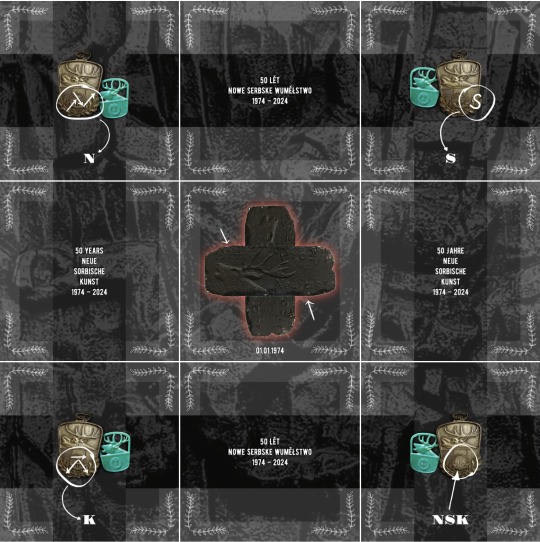
‘50th Anniversary of NSK - January 1st, 1974’ Digital Collage, 375 x 375 mm, 2023 Fine Art Pigment Print under Acrylic Glass, Black Aluminium Art Box
Nothing is further from my mind than to promote the no longer existing East German state by showing GDR symbolism while drunk with nostalgia. For some time now, however, badges from the GDR era have been appearing increasingly, which suggest that New Sorbian Art existed long before the political change in 1989. The badges mentioned show a deer or the head with antlers and oak leaves with the GDR coat of arms in the lower part and are made of cast metal or plastic. The deer is one of the visual anchors in the NSK universe.
An embossed lignite briquette recently appeared in an online auction house, which shows the identical deer motif as on the badge as well as the year '1974' and the words 'Prosit Neujahr (Happy New Year)' in two lines. Should this commemorative briquette be proof of the founding date of the New Sorbian Art? Then the East German NSK would have been founded on January 1st, 1974. It has not yet been possible to reconstruct where exactly this founding meeting took place in Lusatia on the night of December 31st to January 1st, 1974.
Time doesn't just move forward linearly. Traveling back in time on a timeline changes reality there as well as here in the now. It is impossible to imagine what would happen to the 'NSK State In Time' if, at sufficient speed, the space-time curvature made travel in parallel universes of the 'NSK State In Time' possible.
But wait a minute - the tree for the national identity of the Sorbs is the linden tree. But don't the oak leaves show that we are on the wrong track.
#sb2130#Bernhard Schipper#Neue Sorbische Kunst#NSK#Neue Slowenische Kunst#NSK State in Time#NSK State Lipsk#50 Jahre NSK#50.Jahrestag#50th Anniversary#Leipzig Artist#Sorbian Artist#nsk folk art
1 note
·
View note
Photo

Coats of arms of Matthias Corvinus of Hungary (1458–1490)
Matthias's great coat-of-arms. In the middle are personal coat of arms of Matthias Corvinus (Quartered: 1. Hungary's two-barred cross, 2. Árpád dynasty, 3. Bohemia, and 4. Hunyadi family) and that of his wife Beatrice of Naples (Quartered: 1. and 4. Arpad dynasty – France ancient – Jerusalem Impaled; 2. and 3. Aragon), above them a royal crown. On the outer edge there are coat of arms of various lands, beginning from the top clockwise they are: Bohemia, Luxemburg, Lower Lusatia, Moravia, Austria, Galicia–Volhynia, Silesia, Dalmatia-Croatia, Beszterce county
#Coat of Arms#Matthias Corvinus#Hungary#1458#1490#1450s#1490s#1400s#Árpád dynasty#Bohemia#Hunyadi family#Beatrice of Naples#Luxemburg#Lower Lusatia#Moravia#Austria#Galicia-Volhynia#Silesia#Dalmatia-Croation#Beszterce County
10 notes
·
View notes
Text
Witaj, mighty traveler!
For international educational purposes, this blog is in English.
This blog is a new project of mine (@novaspree or @mandalorian-general ), to have a space where I can talk about my homeland. I will share anything related to Lusatia: News, Culture, facts, language, Memes, or just my own shitposts. You will find the files in the search bar, whatever you're looking for!
Whenever you're Lusatian, from other parts of Germany, or from all over the world - we welcome you with open arms! However, do not interact if you're a Neo Nazi/Reichsbürger/fascist of any kind/German "patriot"/ or German supremacist.

What is Lusatia?
Lusatia (Lausitz/ Łužica/ Łužyca) is a region in East Germany, and west Poland, divided into Upper and Lower Lusatia. 1400 years of Germans and Sorbs living side by side guaranteed an unique culture/folklore, dialect, and two languages - nowadays, they are close to going extinct.
Banner source:

#Lusatia#Lausitz#Rjana Łužica#Sorbian#file: blog stuff#Culture#International culture#International blogs#Europe
21 notes
·
View notes
Text
Official Languages in Germany
German – deutsch – is the only language that is recognized nationwide as the official language. However, there are some regional and minority languages that are recognized at the regional or municipal level.
Niederdeutsch (Low German) is spoken by about 2 to 5 million people in Germany, the Netherlands and in the German diaspora. It is recognized as an official language in the states of Hamburg, Schleswig-Holstein, Mecklenburg-West Pomerania, and in parts of Lower Saxony. In the latter state it is part of the German language lessons in school, while in the former states it is a choice among the elective subjects.
Danish is the officially recognized language of the autochtonous Danish minority living in Southern Schleswig, spoken by about 20,000 people. There are special Danish schools were lessons are held in Danish. If a German child wants to attend a Danish school in Schleswig-Holstein, the parents have to learn Danish as the parent-teacher conferences are held exclusively in Danish.
North Frisian belongs to the Anglo-Frisian group of germanic languages and is a recognized minority language in the district of North Frisia in Schleswig Holstein and on the island of Heligoland. It is spoken by less than 10,000 speakers and is listed as an endangered language.
Saterland Frisian is spoken by no more than 1500 to 2000 speakers in a small region of Lower Saxony. It is the last surviving dialect of the East Frisian language and officially recognized as a minority language in the municipality of Saterland. About 300 children learn the language in kindergarten and primary school.
Upper Sorbian is a West Slavonic language spoken by 20,000 to 25,000 people in the region of Upper Lusatia in the tri-border area of Saxony, Brandenburg and Poland. It is taught in schools in the region, there are regional newspapers and radio programs. Street signs are bilingual. The former minister president of Saxony, Stanislaw Tillich, speaks Upper Sorbian as one of his native languages.
Lower Sorbian is the other branch of the West Slavonic language in Germany. It is spoken in Lower Lusatia by 7000 speakers and is critically endangered. The state of Brandenburg actively promotes a revival of the language by offering lessons in school ans kindergarten, radio and TV broadcasts. Street signs are bilingual in places where there is a significant autochthonous minority of speakers of Lower Sorbian.
Romani is an officially recognized minority language in Germany. The most frequently spoken variant in Germany is Sinti-Romanes.
103 notes
·
View notes
Text

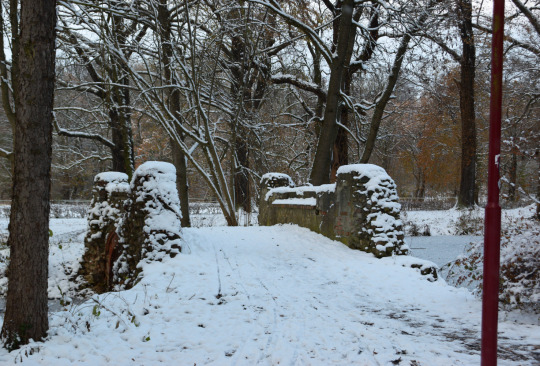
Die Winterbrücke
In einem kleinen Schlosspark führt diese Winterbrücke über den Schlösspark-Teich.
#winter landscape#winter light#Winterbrücke#bright#niederlausitz#lower lusatia#east germany#snow#schnee#winter
29 notes
·
View notes
Text
Lower Sorbian
Minority Languages of Europe Challenge 1/? - Let’s see how many I can do before the semester starts

What is the language called in English and the language itself?
The English name for this language is Lower Sorbian, while in German it is known as Niedersorbisch or Wendisch. In Sorbian, it is called dolnoserbšćina
Where is the language spoken?
Lower Sorbian is spoken in the Lower Lusatia, a region of Eastern Germany bordering Poland.

How many people speak the language?
There are about 7000 native speakers of Lower Sorbian, with a couple more thousand second language speakers
Which language family does it belong to? What are some of its relative languages?
Lower Sorbian is a West Slavic language and most closely related to Upper Sorbian. Other than that, it is related to other West Slavic languages like Polish.
What writing system does the language use?
Both Upper and Lower Sorbian use the Latin alphabet.
What kind of grammatical features does the language have?
Lower Sorbian has 6 grammatical cases: Nominative, Accusative, Dative, Genitive, Instrumental, Locative (Upper Sorbian has an additional Vocative). They are marked with suffixes.
It also has a dual form
What does the language sound like?


What do you personally find interesting about the language?
I recently found out that my surname is Sorbian and that I am half Sorbian on my paternal side. I have no contact to that side of my family and was never exposed to any Sorbian culture other than Easter eggs. I want to learn more about that part of my heritage on my own terms though.
Bonus
a link to my resource post
#langblr#languageblr#languagesofeuropechallenge#language challenge#sorbian#linguistic diversity#linguistic diversity challenge
30 notes
·
View notes
Text
Slavic Gods Associated with the Underworld
Veles
“Slavic people believed that this god is often shown in a form of a bear, even though Veles is capable of transforming into other animals too. But, in later writings, this god is presented as a demon, where he lost his old functions and then linked to the devil and the underworld. Fact is that mythology among early Slavs also developed as their own turbulent lives, so naturally even the gods changed during ages in the eyes of the common folk. When their crops would die out due severe droughts they created a myth how Veles stole the heavenly cows and rains stopped. Even thought Veles with no doubt was considered a “mischievous” God, he was still a subject to worship and respect. It was him that protected farmers cows from plague or improved their crops and land fertility. Average people didn’t want to interfere in mythological fights between Veles and Perun, but in fact worshiped them both as major forces of this world, often according to their own needs.”
“Veles (or Volos) is sometimes called the second most important god of Slavic religion. The old Ruthenian chronicle which calls him skotiy bog makes him the god of cattle. This would also position him as the god of wealth (as cattle was one of the main markers of a family’s wealth). Other hints suggest he could have been linked to such domains as magic, poetry, oaths, the underworld, and the dead.
Veles is sometimes seen as the mythical antagonist of Perun, part of a structural pattern that may reflect a more ancient Indo-European myth of a primordial rivalry between the two opposing supreme deities (compare: Mitra and Varuna in Hindu mythology). Historians and ethnographers suspect that the relics of this ancient notion may have survived even centuries after Christianisation, and can be found in the Slavic Cosmogonic myth which transposes the same theme of rivalry between God and the Devil (See below: Slavic Creation Myth), the latter being a version of Veles. This identification can be observed in Czech folklore as late as the 16th century, where the phrase ‘Jdi za moře k Velesu’ (Go across the sea to Veles!) means ‘Go to the devil!’.”
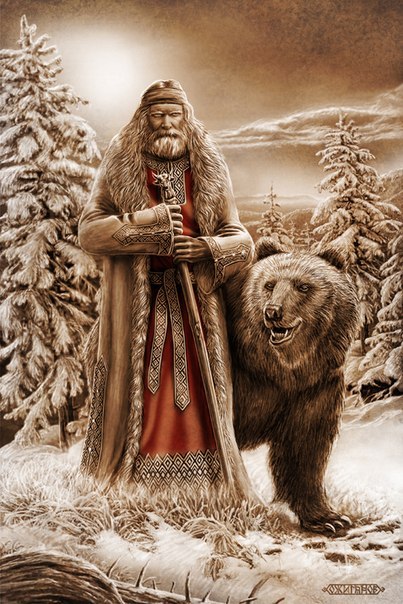
Chernobog
“Also spelled as Czernobog, Tchernobog is a Slavic deity, whose name means black god, about whom much has been speculated but little can be said definitively. The only historical sources, which are Christian ones, interpret him as a dark, accursed god, but it is questionable how important (or evil) he was really considered to be by ancient Slavs.
About Chernobog, there was just one written document named Chronica Slavorum from Saxon missionary Helmold that says:
''Among Slavic people, there is one weird belief that is kept in their drinking fests and feasts. They at same time bless and curse under names of their Gods, respectively in the name of good One and evil One, saying that good things come from good God and evil comes from evil One. In their language they call evil God ''Chernobog'', or ''black God''.''


Morana
“Morana is a pagan Slavic goddess associated with seasonal rites based on the idea of death and rebirth of nature. She is an ancient goddess associated with winter's death and rebirth and dreams. In ancient Slavic rites, the death of the Goddess Marzanna at the end of winter becomes the rebirth of Spring of the Goddess Vesna representing the coming of Spring.”
“In modern times the rituals associated with Marzanna have lost their sacred character and are a pastime – an occasion to have fun and celebrate the beginning of spring. The tradition is usually celebrated around the spring equinox (March 21). Usually schoolchildren and young people participate in the celebrations alongside local folklore groups and other residents. A procession consisting of men, women and children carries handmade Marzanna to the nearest river, lake or pond. The participants sing traditional songs and throw effigies of Marzanna into the water. Sometimes the effigies are first set on fire, or their clothes are torn. On the journey back to the village the focus falls on the copses, adorned with ribbons and blown egg shells. The procession, still singing, returns to the village."
“Researchers emphasise that Marzanna functioned not merely as a symbol of winter, but also as a Slavic goddess. Marzanna's later association with death (in some regions Marzanna is called Death Crone) trivialized the importance of the goddess, who was the lady of not only death, but also life, and commanded the natural world.”
“Drowning Marzanna in water (an element of high importance in season-related folk celebrations) is understood as the goddess' symbolic descent into the underworld, to be reborn with next winter. Some researchers underline the sacrificial character of this ritual and suggest that Marzanna is sacrificed in order to appease Winter. The authors of Wyrzeczysko propose that Marzanna is sacrificed to the demons of water, whose favour was necessary to ensure a plentiful harvest in the coming year.”

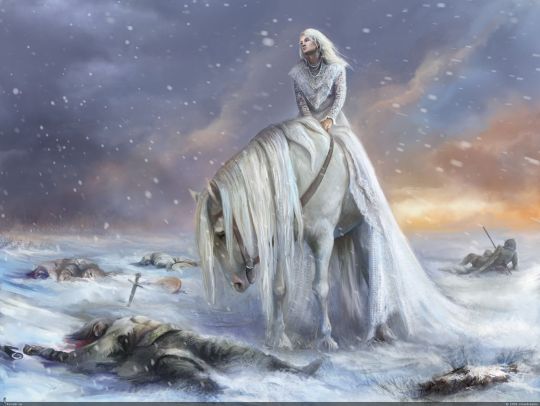

Karna
“Goddess of the funerals, personifying tears. She is compared to the Indic Karna.”
“Yet another goddess of death, the ancient Karna is depicted as a young woman with black hair and bright red clothes. She is said to be the daughter of the goddess Lada. She spends most of her life down in the underworld. Some sources claim her to be related to Marzana (the goddess of winter and death, it might be a region differential)”
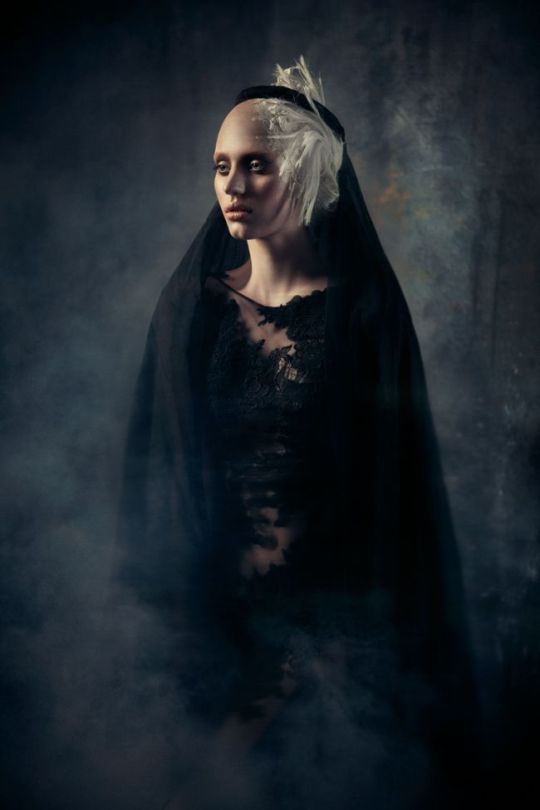
Oźwiena
“Goddess of the echo, and generally of voice and oral communication.”
“She was a companion of the god Veles, the goddess of echo. Some specialists in mythology connect her with Greek nymph Echo. She was also the goddess of gossip. According to the legend, it was impossible to her keep something she heard as a secret. Whatever you told her, she shared it. However, if she liked someone, she spoke only good things, but when someone became her enemy, she spoke all the bad things about this person. Moreover, Oźwiena loved glory, fame and listening to the stories.”

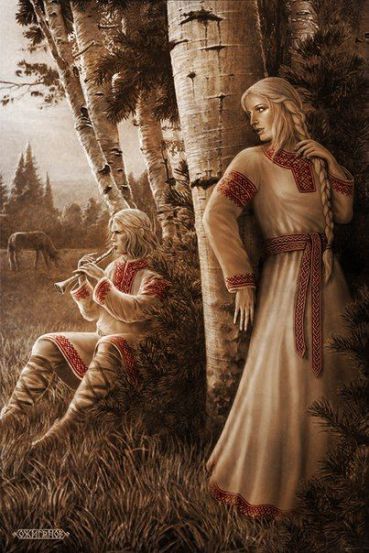
Flins /Hela
“Hela, the death goddess, is represented with a lion head with an outstretched tongue. As Myda, an aspect or another name of hers, she is represented as a crouching dog.”
“God of death who may be a Wendish name of Veles, although the iconography is rather different. He is sometimes represented as a skeleton with a lion upon his shoulder, holding a burning torch in his hand, and placing a foot on a large pebble. In other cases he is represented as an old man, with the same attributes of the skeleton, except for a flint instead of a pebble. His cult was widespread in Lower Silesia, Lusatia and Saxony.”

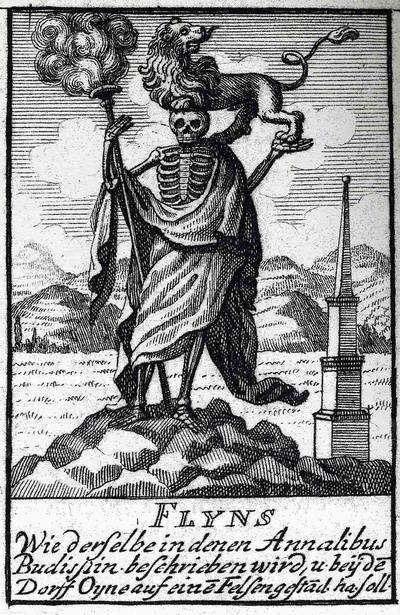

Morok
“Morok, literally “Darkness” in Russian, is a concept that has been deified in modern Slavic Native Faith (Rodnovery). He is the god of lie and a deceit, ignorance and errors. At the same time, he is a keeper of ways to the truth, hiding such ways to those who pursue truth for vanity and selfishness. He has a twin brother, Moroz (“Frost”), and they switch into one another at will.”

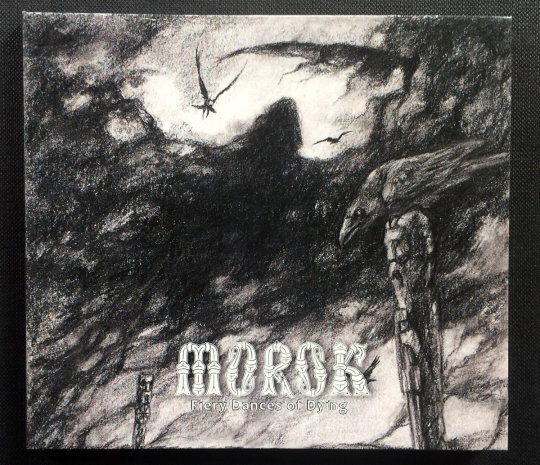
Nemiza
���God who cuts the thread of life, sometimes represented as a male with four beams around his head, one wing, and on his chest a dove with outstretched wings, and sometimes represented as a naked female with an eagle by her side gazing up to her. Nemiza was regarded both as a calamity for bringing death, and as a beneficial figure for introducing the soul to a new life.”

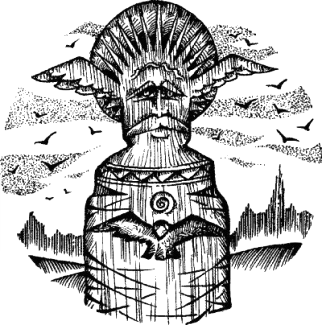

Ny
“Ny is the god of the underworld who acts as psychopomp, that is to say the guide of the souls into the underworld. He is associated with subterranean fire and water, snakes and earthquakes. Peklabog or Pekelnybog is another name of the god of the underworld, and he has been compared to the Indic Shiva. Etymologically, the word peklo means "pitch", and after Christianisation, its meaning became that of "hell", often personified as the Devil, and pekelnik any being of hell.”
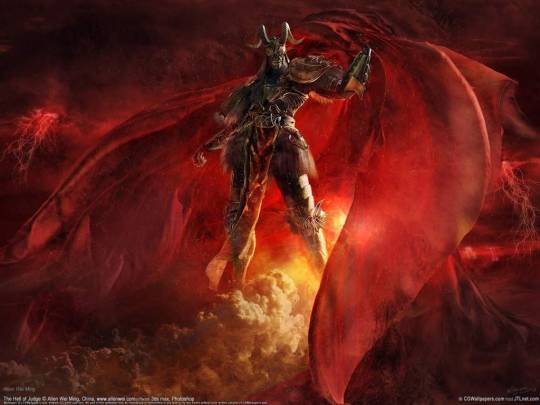
https://www.slavorum.org/veles-the-slavic-shapeshifting-god-of-land-water-and-underground/
https://mythology.wikia.org/wiki/Chernobog
https://en.wikipedia.org/wiki/Morana_(goddess)
https://en.wikipedia.org/wiki/Deities_of_Slavic_religion
https://aminoapps.com/c/pagans-witches/page/blog/dark-slavic-gods-goddesses/xpdX_JM6s2uVLKp7bdXgQmXmqBXQQrvBvG
https://culture.pl/en/article/what-is-known-about-slavic-mythology
22 notes
·
View notes
Text

Hi! I'm Maria Theresa, by the Grace of God, Dowager Empress of the Romans, Queen of Hungary, of Bohemia, of Dalmatia, of Croatia, of Slavonia, of Galicia, of Lodomeria, etc.; Archduchess of Austria; Duchess of Burgundy, of Styria, of Carinthia and of Carniola; Grand Princess of Transylvania; Margravine of Moravia; Duchess of Brabant, of Limburg, of Luxemburg, of Guelders, of Württemberg, of Upper and Lower Silesia, of Milan, of Mantua, of Parma, of Piacenza, of Guastalla, of Auschwitz and of Zator; Princess of Swabia; Princely Countess of Habsburg, of Flanders, of Tyrol, of Hainault, of Kyburg, of Gorizia and of Gradisca; Margravine of Burgau, of Upper and Lower Lusatia; Countess of Namur; Lady of the Wendish Mark and of Mechlin; Dowager Duchess of Lorraine and Bar, Dowager Grand Duchess of Tuscany, and you're watching Disney Channel! <3
1K notes
·
View notes
Text

SPREEWALD: The Spree Forest is a large inland delta of the river Spree, and a historical cultural landscape located in the region of (Lower) Lusatia, in the state of Brandenburg, Germany, about 100 km southeast of Berlin and close to the city of Cottbus.
0 notes
Photo

The Superkokot, a Sorbian tradition, is a harvest celebration where all Erntekönige (Harvest King) fight for the title of the Super-Kral. The 3-year-old cock named "Heinrich II" had already been dead when he got attached to the oak portal. The contestants have to ripp off the head first, then the wings.
“ When times get more restless and the future more uncertain, then we long for security. Heimat triggers pictures of memories, it has a past. Heimat arouses a longing for solid roots. The Sorbs have found a home in a country that was not theirs at first. Stateless they have maintained their own identity over the centuries, their own language and tradition. Today, the West Slavic ethnic group belongs is one of the four official minorities in Germany. More than 1,400 years ago, the Elbe Slavic tribes settled at the end of the big migration in the almost depopulated areas north of the mountains of the Lusatian-, Erz- and Fichtelgebirges. Today, they live in the villages of Lusatia: in the Saxon Upper Lusatia, where the language resembles the Czech and in the Lower Lusatia in Brandenburg with a language that resembles the Polish and where they are also called 'Wenden'. It is a mixed national and bilingual Lusatia. The Sorbs live in their homeland together with fellow German citizens, but as a minority. Extensive fields, magnificent forests, small villages, town signs in German and Sorbian, small front gardens, churches, prayer columns and again and again crosses: The picture looks as if it was from a parallel society. It is an emotionally colorful life when you grow up with an old custom, you are connected with it from childhood on. People used to grow into their costume and never came out again. Today, the once ordinary has become something special with the hope that it will not be forgotten. The costume is an important part of the identity that has repeatedly defied oppression. Over the centuries, the settlement area of the Sorbs became smaller and smaller, and more and more non-Sorbs settled in the area. In the 13th century immigrated masses of German craftsmen and farmers from other areas populated the areas. They marginalized the Sorbs through language bans and non-admission to guilds. In the aftermath of the Second World War, re-settlers and displaced people from the eastern regions came. With the industrialization German workers were brought into the lignite mining. It was lignite that ate up the Sorbian countryside in recent decades, more than 136 villages have now disappeared and more than 25,000 people have lost their homes and traditional village community. In the Nazi era, the Sorbs were persecuted, the language and the Sorbian press banned. The DDR promoted the Sorbian culture, but the Sorbian identity fell more and more into oblivion. Institutions, associations and communities work against the oblivion. Saxony and Brandenburg have firmly anchored protection and promotion of the Sorbs into the constitution. As a national minority, the Sorbs are historically rooted in Germany, their relatives have German citizenship, but their identity is expressed in their own culture and language. There are Sorbian kindergartens and schools, services are held in Sorbian language. There is a daily newspaper and magazines, own TV shows. No one knows how long the Sorbian language can survive. There are only a limited number of Sorbian words and the language did not adapt to modern times. You keep hearing German words in Sorbian conversations. Only about 20,000 Sorbs speak the language today, with some 7,000 actively speaking Lower Sorbs, according to some estimates in approximately 30 years, the native speakers may have died out. There is no exact number of Sorbs, the commitment to the Sorbian nationality is of free choice and Germany does not track nationality affiliation. Thus, it is estimated that today about 60,000 Sorbs live in Brandenburg and Saxony. Especially in the vicinity of the cultural centers in Cottbus and Bautzen, there are always hostility from right-wing populist groups. The Sorbian youth stands up against it and celebrates their old traditions. How does it feel to have roots in statelessness? To live as a minority in a modern German country and to defy all hostility, oppression and assimilation attempts with the preservation of one's own identity?”
- Christina Czybik
123 notes
·
View notes